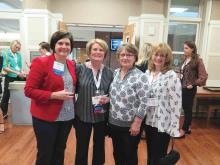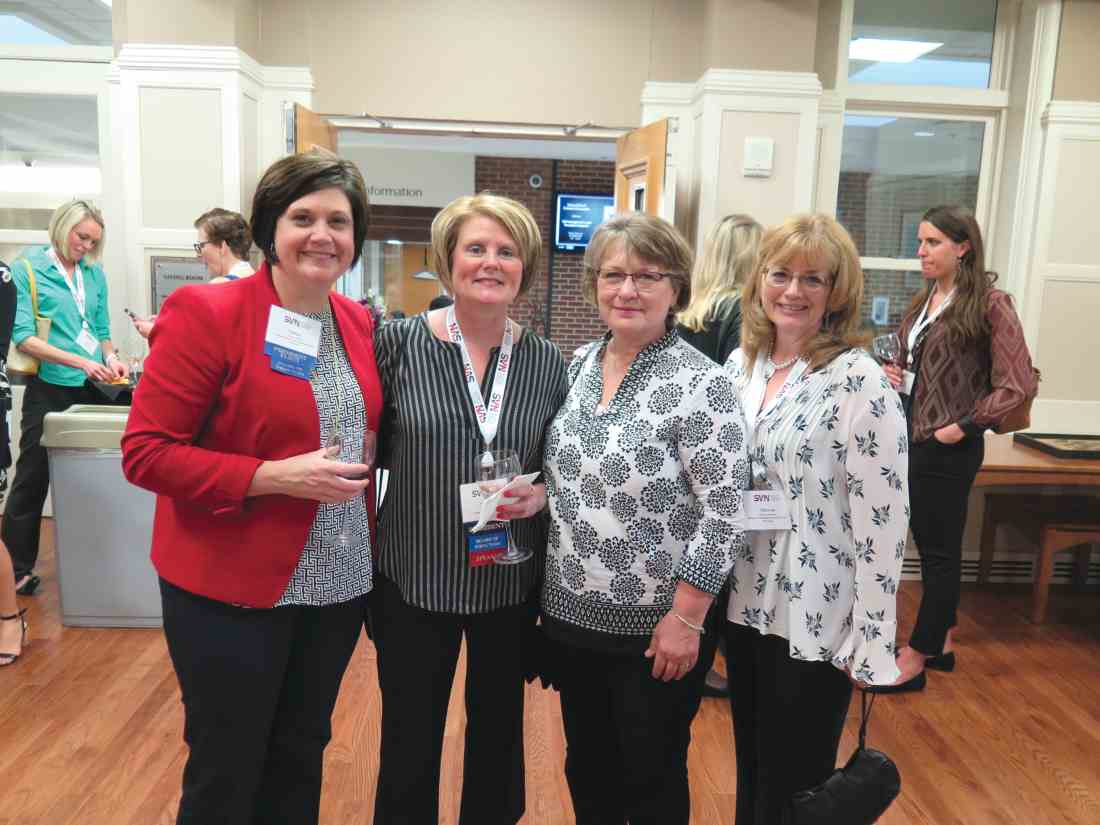User login
It seems fitting, said Tiffany Street, President of the Society for Vascular Nursing, that SVN and SVS have their conferences in the same location and with overlapping times.
“It parallels what we do every day in clinical practice,” she said. “Recently, we have focused our attention on the emphasis of the clinical vascular care team. Physicians and nurses collaborate daily on the care of vascular patients so collaboration in the learning environment is imperative.”
SVN’s 36th Annual Conference, SVN @SVS, will be held June 20 to 21, coinciding with the opening two days of VAM. The SVN conference registration fee permits entrance to VAM, as well.
Both organizations are emphasizing the team approach to vascular care this year, with SVN also stressing vascular education and the holistic approach to vascular patient care, Ms. Street said. An abstract session Thursday will focus on “The Vascular Team Connections,” with two abstract presentations plus a panel discussion on “How Collaboration Changes a Patient.” Speakers include surgeon and SVS President R. Clement Darling III, MD; a physician assistant, Erin Hanlon, PA-PAC; and two nurses, Marie Rossi, BS, RN, and Karen Fitzgerald, MSN, RN, NP.
The team approach is vitally important, Ms. Street said. “Vascular nursing is responsible for the care of the patient across the continuum in collaboration with the surgeon,” she said.
Undergoing a surgical procedure affects not only the patient but also the patient’s family, she pointed out. “Because the family support system is vital to good postoperative outcomes, vascular nurses support the family as well.” Nurses cover with the patient and family what they all might expect during the patient’s recovery, helping them think through the various issues and how best to manage them, she said. “It’s all part of the team approach.”
Abstract sessions at SVN @SVS will focus on CLI, AAA, carotid artery, PAD, venous and arterial compression, and vascular team connections. Concurrent sessions will target both the novice and experienced nurse, plus include other emphases, as well. Several SVS members will be presenters at SVN sessions.
The keynote address will cover the care of patients from the Boston Marathon bombing in 2013. Jonathan Gates, MD, who was Medical Director of Trauma Services at Brigham and Women’s Hospital at the time of the bombing and operated on bombing victims that day, will present the address. Other sessions at the Vascular Annual Meeting also stress the vascular team and patient benefits, including “Team Forum: Improving Metrics in Clinical Practice,” from 1:30 to 3 p.m. Friday. Nurses are sure to find topics of interest at VAM, said Dr. Darling. “I find the team approach integral to optimal patient outcomes,” he said. “I could not be happier at including all members of the team at this year’s VAM, from the special programming for physician assistants on Thursday afternoon to SVN @SVS.
“When we work together,” he said, “everyone benefits, especially the patient.”
Visit vsweb.org/SVN18conference or the VAM Planner (vsweb.org/VAMPlanner) for the complete schedule and more information.
It seems fitting, said Tiffany Street, President of the Society for Vascular Nursing, that SVN and SVS have their conferences in the same location and with overlapping times.
“It parallels what we do every day in clinical practice,” she said. “Recently, we have focused our attention on the emphasis of the clinical vascular care team. Physicians and nurses collaborate daily on the care of vascular patients so collaboration in the learning environment is imperative.”
SVN’s 36th Annual Conference, SVN @SVS, will be held June 20 to 21, coinciding with the opening two days of VAM. The SVN conference registration fee permits entrance to VAM, as well.
Both organizations are emphasizing the team approach to vascular care this year, with SVN also stressing vascular education and the holistic approach to vascular patient care, Ms. Street said. An abstract session Thursday will focus on “The Vascular Team Connections,” with two abstract presentations plus a panel discussion on “How Collaboration Changes a Patient.” Speakers include surgeon and SVS President R. Clement Darling III, MD; a physician assistant, Erin Hanlon, PA-PAC; and two nurses, Marie Rossi, BS, RN, and Karen Fitzgerald, MSN, RN, NP.
The team approach is vitally important, Ms. Street said. “Vascular nursing is responsible for the care of the patient across the continuum in collaboration with the surgeon,” she said.
Undergoing a surgical procedure affects not only the patient but also the patient’s family, she pointed out. “Because the family support system is vital to good postoperative outcomes, vascular nurses support the family as well.” Nurses cover with the patient and family what they all might expect during the patient’s recovery, helping them think through the various issues and how best to manage them, she said. “It’s all part of the team approach.”
Abstract sessions at SVN @SVS will focus on CLI, AAA, carotid artery, PAD, venous and arterial compression, and vascular team connections. Concurrent sessions will target both the novice and experienced nurse, plus include other emphases, as well. Several SVS members will be presenters at SVN sessions.
The keynote address will cover the care of patients from the Boston Marathon bombing in 2013. Jonathan Gates, MD, who was Medical Director of Trauma Services at Brigham and Women’s Hospital at the time of the bombing and operated on bombing victims that day, will present the address. Other sessions at the Vascular Annual Meeting also stress the vascular team and patient benefits, including “Team Forum: Improving Metrics in Clinical Practice,” from 1:30 to 3 p.m. Friday. Nurses are sure to find topics of interest at VAM, said Dr. Darling. “I find the team approach integral to optimal patient outcomes,” he said. “I could not be happier at including all members of the team at this year’s VAM, from the special programming for physician assistants on Thursday afternoon to SVN @SVS.
“When we work together,” he said, “everyone benefits, especially the patient.”
Visit vsweb.org/SVN18conference or the VAM Planner (vsweb.org/VAMPlanner) for the complete schedule and more information.
It seems fitting, said Tiffany Street, President of the Society for Vascular Nursing, that SVN and SVS have their conferences in the same location and with overlapping times.
“It parallels what we do every day in clinical practice,” she said. “Recently, we have focused our attention on the emphasis of the clinical vascular care team. Physicians and nurses collaborate daily on the care of vascular patients so collaboration in the learning environment is imperative.”
SVN’s 36th Annual Conference, SVN @SVS, will be held June 20 to 21, coinciding with the opening two days of VAM. The SVN conference registration fee permits entrance to VAM, as well.
Both organizations are emphasizing the team approach to vascular care this year, with SVN also stressing vascular education and the holistic approach to vascular patient care, Ms. Street said. An abstract session Thursday will focus on “The Vascular Team Connections,” with two abstract presentations plus a panel discussion on “How Collaboration Changes a Patient.” Speakers include surgeon and SVS President R. Clement Darling III, MD; a physician assistant, Erin Hanlon, PA-PAC; and two nurses, Marie Rossi, BS, RN, and Karen Fitzgerald, MSN, RN, NP.
The team approach is vitally important, Ms. Street said. “Vascular nursing is responsible for the care of the patient across the continuum in collaboration with the surgeon,” she said.
Undergoing a surgical procedure affects not only the patient but also the patient’s family, she pointed out. “Because the family support system is vital to good postoperative outcomes, vascular nurses support the family as well.” Nurses cover with the patient and family what they all might expect during the patient’s recovery, helping them think through the various issues and how best to manage them, she said. “It’s all part of the team approach.”
Abstract sessions at SVN @SVS will focus on CLI, AAA, carotid artery, PAD, venous and arterial compression, and vascular team connections. Concurrent sessions will target both the novice and experienced nurse, plus include other emphases, as well. Several SVS members will be presenters at SVN sessions.
The keynote address will cover the care of patients from the Boston Marathon bombing in 2013. Jonathan Gates, MD, who was Medical Director of Trauma Services at Brigham and Women’s Hospital at the time of the bombing and operated on bombing victims that day, will present the address. Other sessions at the Vascular Annual Meeting also stress the vascular team and patient benefits, including “Team Forum: Improving Metrics in Clinical Practice,” from 1:30 to 3 p.m. Friday. Nurses are sure to find topics of interest at VAM, said Dr. Darling. “I find the team approach integral to optimal patient outcomes,” he said. “I could not be happier at including all members of the team at this year’s VAM, from the special programming for physician assistants on Thursday afternoon to SVN @SVS.
“When we work together,” he said, “everyone benefits, especially the patient.”
Visit vsweb.org/SVN18conference or the VAM Planner (vsweb.org/VAMPlanner) for the complete schedule and more information.

